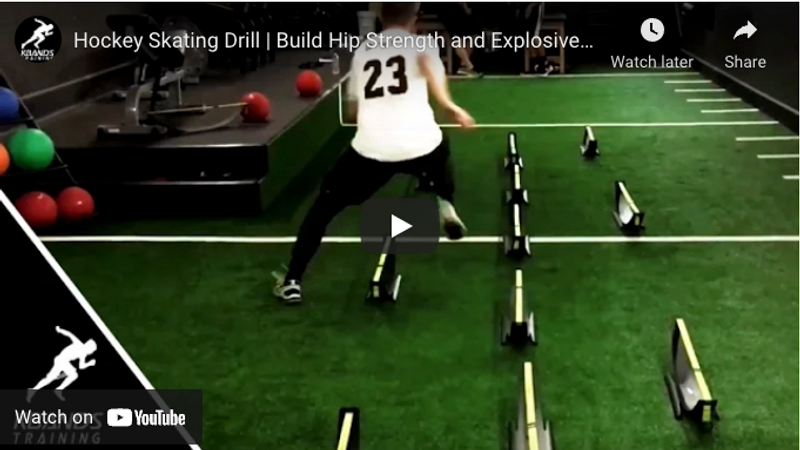Hip and Core Strength for Hockey Skating: Building Strength
Hip and core stability are vital for keeping the body moving forward, especially in a driving and explosive sport like hockey. Weak hip and core strength can result in weaker movement overall because movement originates from the core. If the core is strong, then hip movement will be even more powerful. This dynamic hockey skating drill is going to blend together the most important movements for hockey players in order to increase hockey skating and stride. This hockey skating drill is designed to target the muscles of the legs especially the glutes, IT Band, quads, and hamstrings. The majority of a player’s time on the ice is spent in a squat or lunge position, so being able to maintain posture and the legs to not weaken in this stance is important. If the legs become weak in this athletic stance that will affect the power of take off on the ice.
Hip and core strength are connected and together create the driving force for powerful athletic movement. Speed and agility will all originate from these sources so weak hips and core mean weak hockey skating speed and a slower stride. This Kbands hockey skating drill is going to challenge the hip muscles for powerful movement and greater stability on the ice. Utilizing Kbands are going to enhance results. The Kbands Resistance Bands are designed to activate the glute and hip muscles in a specific way to build muscular strength and power on the ice. Hockey skating requires powering through the friction of the ice in a lateral, yet simultaneous forward motion. This Kbands hockey skating drill will build strength and explosiveness for this unique hockey skating stride movement. The addition of Kbands also works to increase the heart rate, there fore stamina on the ice and hockey skating.
Kbands Hockey Skating Drill: Step Over Hip Drill
This hockey skating drill will include two variations for increased hockey skating speed, power, and muscle activation in the legs.
Strap on the Kbands Leg Resistance Bands to increase the resistance and muscle activation of this hockey skating drill. The only other equipment necessary are flat cones. The amount of cones used depends on the player and cones can be easily added or taken away to increase difficulty. Place the cones in a line about a foot apart, depending on the player. In a lateral motion, drive the knees up and over the cones. Activate the muscles of the core and drive the knees up to increase resistance of the hip flexors. Do not allow the knees to internally rotate; the Kbands are designed to force the user to activate the glutes and keep the knees in proper alignment for great muscle activation. This muscle activation is what makes this great for improved hockey skating. Maintaining core activation and stability is key to optimizing this hockey skating drill and performing above the rest. This core stability will allow muscles to be properly activated because the body is precise alignment.
Go down and back and then down again, using this last time back to the front as a preparation for a sprint at the end. Complete the down and back with a ten yard sprint, making this hockey skating drill the most dynamic way to train. Perform 6-8 repetitions on this step over hockey skating drill.
Kbands Hockey Skating Drill: Zigzag Lateral Drill for Hip Power
For this version of the hockey skating drills, set up cones or hurdles at forty-five degree angles in a zigzag shape, no more than twelve yards long. Each cone or hurdle should be a foot or two apart. Start at one end of the zigzag and then drive the knees up and over the cones or hurdles from side to side, while also moving forward towards the front of the formation. Drive the knees up and over, this is really activating the hip flexors, abductors, glutes, and core. In order to optimize this lateral movement pump the arms and really use them when driving the knees up, all while maintaining proper form and an activated core.
Perform 6-8 repetitions of this hockey skating drill. Hockey skating drills off the ice will aid in increasing speed and agility on the ice. The addition of Kbands during this hockey skating drill is key in increasing resistance to mimic the friction and resistance of the ice. This unique muscle activation is vital in increasing power and performance on the ice for any hockey player. Increased hockey skating speed is vital in being above all the rest on the ice and maximizing performance.
After performing the initial resisted hockey skating drill sets, perform a few sets of the same drill without the Kbands Leg Resistance Bands. This will help the legs to feel free and users experience the effect of the Kbands Resistance Bands during this drill for hockey skating.

